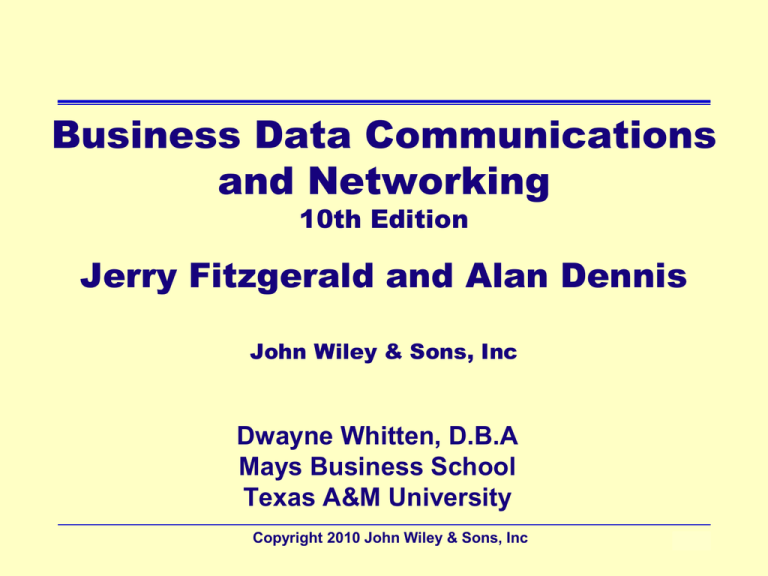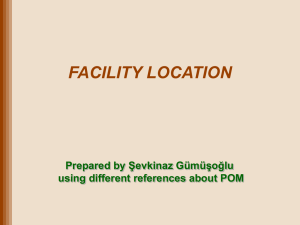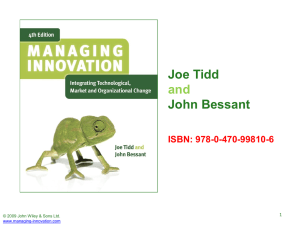
Business Data Communications
and Networking
10th Edition
Jerry Fitzgerald and Alan Dennis
John Wiley & Sons, Inc
Dwayne Whitten, D.B.A
Mays Business School
Texas A&M University
Copyright 2010 John Wiley & Sons, Inc
7-1
Chapter 7
Wireless
Local Area Networks
Copyright 2010 John Wiley & Sons, Inc
7-2
Chapter 7: Outline
• Introduction
• WLAN Components
• WI-FI
• WIMAX
• Bluetooth
• Best practice WLAN Design
• Improving WLAN Performance
• Management Implications
Copyright 2010 John Wiley & Sons, Inc
7-3
Wireless LANs (WLANs)
• Use radio or infrared frequencies to transmit
signals through the air (instead of cables)
• Basic Categories
– Use of Radio frequencies (FOCUS of this chapter)
• 802.1x family of standards (aka, Wi-Fi)
– Use of Infrared frequencies (Optical transmission)
• Wi-Fi grown in popularity
– Eliminates cabling
– Facilitates network access from a variety of locations
– Facilitates for mobile workers (as in a hospital)
– Used in 90 percent of companies
Copyright 2010 John Wiley & Sons, Inc
7-4
Principal WLANs Technologies
• WI-FI
– IEEE 802.11b
• Standardization started after .11a, but finished
before, more commonly used than .11a
– IEEE 802.11a
• First attempt to standardization of WLANs; more
complicated than .11b
– IEEE 802.11g
• WIMAX
• Bluetooth
– Also an IEEE standard 802.15
Copyright 2010 John Wiley & Sons, Inc
7-5
Components of WLANs
• Network Interface Cards
– Many laptops come with WLAN cards built in
– Also available as USB cards
– About 100-300 feet max transmission range
• Access Points (APs)
– Used instead of hubs; act as a repeater
• Must hear all computers in WLAN
• Some use power over Ethernet (POE)
Copyright 2010 John Wiley & Sons, Inc
7-6
Antennas used in WLANs
• Omni directional antennas
– Transmit in all directions simultaneously
– Used on most WLANs
• Dipole antenna (rubber duck)
– Transmits in all direction (vertical, horizontal, up, down)
• Directional antennas
– Project signal only in one direction
• Focused area; stronger signal; farther ranges
– Most often used on inside of an exterior wall
• To reduce the security issue
– A potential problem with WLANs
– Antennas can be made from Pringles, etc. cans and are
called “Cantennas”
Copyright 2010 John Wiley & Sons, Inc
7-7
Types of Antennas
Copyright 2010 John Wiley & Sons, Inc
7-8
WLAN Radio Frequencies
• WLANs use radio transmissions to send data
between the NIC and the AP
• Most countries use the 2.4 GHz range and the 5
GHz range
• The larger the frequency range, the greater the
bandwidth, or capacity
• It is important to ensure that APs do not conflict
with each other
• Therefore, each AP is set up to transmit on a
different part of the 2.4 or 5 GHz frequency range
Copyright 2010 John Wiley & Sons, Inc
7-9
More on the APs and NICs
• 3 separate channels available for 802.11b
– All devices using an AP must use the same channel
• WLAN functions as a shared media LAN
– Reduces the interference
– Users can roam from AP to AP
• Initially NIC selects a channel (thus an AP)
– Based on “strength of signal” from an AP
• During roaming, if NIC sees another AP with a
stronger signal, attaches itself to this AP
• Usually a set of APs installed to provide
geographical coverage and meet traffic needs
– NICs selects a less busy channel if its current channel
becomes busy (too many users)
Copyright 2010 John Wiley & Sons, Inc
7 - 10
A WLAN Using Different Channels
Copyright 2010 John Wiley & Sons, Inc
7 - 11
WLAN Topology
Same as Ethernet
• Physical star
• Logical bus
Use the same radio
frequencies, so
take turns using
the network
10Base-T or
100Base-T
Uses a NIC that
transmits radio
signals to the AP
A wireless Access Point (AP) connected
into an Ethernet Switch
Copyright 2010 John Wiley & Sons, Inc
7 - 12
WLAN Media Access Control
• Uses CSMA/CA
– CA collision avoidance
– A station waits until another station is finished
transmitting plus an additional random period of time
before sending anything
• May use two MAC techniques simultaneously
– Distributed Coordination Function (DCF)
• Also called “Physical Carrier Sense Method”
– Point Coordination Function (PCF)
• Also called “Virtual Carrier Sense Method”
• Optional: (can be set as “always”, “never”, or “just
for certain frame sizes”)
Copyright 2010 John Wiley & Sons, Inc
7 - 13
Distributed Coordination Function
• Relies on the ability of computers to physically
listen before they transmit
– When a node wants to send a message:
• First listens to make sure that the transmitting node
has finished, then
• Waits a period of time longer
• Each frame is sent using stop-and-wait ARQ
– By waiting, the listening node can detect that the
sending node has finished and
– Can then begin sending its transmission
– ACK/NAK sent a short time after a frame is received,
– Message frames are sent a somewhat longer time after
(ensuring that no collision will occur)
Copyright 2010 John Wiley & Sons, Inc
7 - 14
Point Coordination Function (PCF)
• Solves Hidden Node problem
– Two computers can not detect each other’s signals
• A computer is near the transmission limits of the AP
at one end and another computer is near the
transmission limits at the other end of the AP’s range
– Physical carrier sense method will not work
• Solution
– First send a Request To Send (RTS) signal to the AP
• Request to reserve the circuit and duration
– AP responds with a Clear To Send (CTS) signal,
• Also indicates duration that the channel is reserved
– Computer wishing to send begins transmitting
Copyright 2010 John Wiley & Sons, Inc
7 - 15
Types of Wi-Fi
• IEEE 802.11a
• IEEE 802.11b
• IEEE 802.11g
• IEEE 802.11n
Copyright 2010 John Wiley & Sons, Inc
7 - 16
IEEE 802.11a
• Operates in a 5 GHz frequency range
• Total bandwidth is 300 MHz
– Faster data rates possible: Up to 54 Mbps
• 6, 9, 12, 18, 24, 36, 48, and 54 Mbps
• Uses the same topology as .11b
• Reduced range because of higher speed
– 50 meters ( 150 feet)
– Highest speed achievable within 15 meter
Copyright 2010 John Wiley & Sons, Inc
7 - 17
IEEE 802.11b
• Moderate speed networking in the 2.4GHz
range
• Three channels for indoor use in the US,
more or less in other parts of the world
• Each channel has a maximum data rate of
11 Mbps, for users close to the center of
the WLAN 6-11 Mbps is the norm
• 802.11b suffers less attenuation than
802.11a
• Designed to connect easily to Ethernet
Copyright 2010 John Wiley & Sons, Inc
7 - 18
IEEE 802.11g
• Designed to combine advantages of 802.11a and
802.11b
– Offers higher data rates (up to 54 Mbps) in 2.4 GHz band
(as in .11b) with longer ranges
– Backward compatible with 802.11b
• .11b devices can interoperate with .11g APs
• Price to pay: when an .11g AP detects an .11b device,
it prohibits .11g devices from operating at higher
speeds
• Uses the same topology as .11b
– Provides 3-6 channels (depending on configuration)
– 54 Mbps rate obtained within 50 meter range
Copyright 2010 John Wiley & Sons, Inc
7 - 19
802.11g Media Access Control
• Almost the same media and error control
protocols as .11b
– Similar packet layout, except
• Preambles and headers transmitted at
slower speeds (up to a maximum of 11
Mbps)
• Payload transmitted at higher speeds (up to
a max of 54 Mbps)
• Data Transmission in the Physical Layer
– Same techniques in .11a and .11b
Copyright 2010 John Wiley & Sons, Inc
7 - 20
IEEE 802.11n
• Standard under development
• Goal to provide high speed wireless
networking
• Uses both the 2.4 and 5 GHz frequency
ranges simultaneously
• Current drafts propose speeds of 250-300
Mbps, but 100 more likely
• Backward compatible with a, b, and g
Copyright 2010 John Wiley & Sons, Inc
7 - 21
WI-FI as Public Internet Access
• Wi-Fi was intended to be used for indoor
mobile wireless access
• Many providers have in airports and malls
and other public places
• Political issues, not technical, interfere
with the large scale provision of Wi-Fi
• Being offered by some towns as well as
carriers
Copyright 2010 John Wiley & Sons, Inc
7 - 22
WIMAX
• Commercial name for family of IEEE
802.16 standards
• Two primary types: Fixed and mobile
• Logical and physical topology same as
802.11 and shared Ethernet
• Uses controlled access with a version of
802.11 point coordination function
• Two types:
– 802.16d
– 802.16e
Copyright 2010 John Wiley & Sons, Inc
7 - 23
IEEE802.16d
• Fixed point wireless access
• Antennas 12-18 inches
• One central access point allows
connection to fixed networks
• Ideal – 70 Mbps and 30 mile range
• Expect – 2 Mbps and 5 mile range
Copyright 2010 John Wiley & Sons, Inc
7 - 24
IEEE802.16e
• For mobile users
• Multiple channels, each with 28 Mbps
• Effective rate of 5 Mbps
• Effective range of 6 miles with line of sight
• Effective range of 2½ miles without line of
sight
Copyright 2010 John Wiley & Sons, Inc
7 - 25
Issues to consider with WIMAX
• WIMAX is a competitor to public access
Wi-Fi and cellular phone service
• WIMAX is incompatible with both
• Has an effective range that offers benefits
• Has controlled access, version of PDF
• Considerably more distance covered with
WIMAX over Wi-Fi
Copyright 2010 John Wiley & Sons, Inc
7 - 26
Bluetooth (IEEE 802.15)
• A standard for Wireless Personal Area Network
(WPAN)
– Provides networking in a very small area
• Up to 10 meters (current generation)
• Up to 100 meters (next generation)
– Includes small (1/3 of an inch square) and cheap devices
designed to
• Replace short distance cabling between devices
– Keyboards, mouse, handsets, PDAs, etc
– Provides a basic data rate of 1 Mbps
• Can be divided into several voice and data channels
Copyright 2010 John Wiley & Sons, Inc
7 - 27
Bluetooth Topology
• Uses the term “piconet” to refer to a
Bluetooth network
– Consists of 8 devices
• A “master” device controlling other devices,
“slaves”
– Acts like an AP
– Selects frequencies and controls access
– All devices in a piconet share the same
frequency range
Copyright 2010 John Wiley & Sons, Inc
7 - 28
Bluetooth Media Access Control
• Uses Frequency Hopping Spread Spectrum (FHSS)
– Available frequency range (2.4000-2.4835) divided into 79
separate 1-MHz channels
– A data burst transmitted using one channel, next data
burst uses the next channel, and so on.
– Channels changed based on a sequence and established
by the slave and the master prior to the data transfers
• 1,600 hops or channel changes per second
– Also used to minimize interference
• A noisy channel avoided eventually
• Not compatible with 802.11b
– Potential interference problems (especially if many
Bluetooth devices present close to .11b devices)
Copyright 2010 John Wiley & Sons, Inc
7 - 29
Best Practice Recommendations
• Select best one, cost permitting
• Adopt 802.11g or n
– Will replace 802.11b and .11a
– Prices of .11g and n NICs and APs coming down
• Wireless vs. Wired
• Similar data rates for low traffic environment
• When mobility important 802.11g or n
• Using WLAN as an “overlay network,” or in conjunction
with a wired LAN
– WLANs installed In addition to wired LANs
– To provide mobility for laptops
– To provide access in hallways, lunch rooms, other sites
Copyright 2010 John Wiley & Sons, Inc
7 - 30
Physical WLAN Design
• More challenging than designing a traditional LAN
– Use a temporary AP and laptop to evaluate placement of
APs
– Locations are chosen to provide coverage as well as to
minimize potential interference
• Begin design with a site survey, used to determine:
– Feasibility of desired coverage
• Measuring the signal strength from temporary APs
– Potential sources of interference
• Most common source: Number and type of walls
– Locations of wired LAN and power sources
– Estimate of number of APs required
Copyright 2010 John Wiley & Sons, Inc
7 - 31
Physical WLAN Design
• Begin locating APs
– Place an AP in one corner
– Move around measuring the signal strength
– Place another AP to the farthest point of coverage
• AP may be moved around to find best possible spot
• Also depends on environment and type of antenna
– Repeat these steps several times until the corners are
covered
– Then begin the empty coverage areas in the middle
• Allow about 15% overlap in coverage between APs
– To provide smooth and transparent roaming
• Set each AP to transmit on a different channel
Copyright 2010 John Wiley & Sons, Inc
7 - 32
WLAN Design Specs for 802.11g
Copyright 2010 John Wiley & Sons, Inc
7 - 33
Multistory WLAN Design
• Must include
– Usual horizontal mapping, and
– Vertical mapping to minimize interference from APs on
different floors
Copyright 2010 John Wiley & Sons, Inc
7 - 34
WLAN Security
• Especially important for wireless network
– Anyone within the range can use the WLAN
• Finding a WLAN
– Move around with WLAN equipped device and
try to pick up the signal
– Use special purpose software tools to learn
about WLAN you discovered
• Wardriving – this type reconnaissance
• Warchalking – writing symbols on walls to
indicate presence of an unsecure WLAN
Copyright 2010 John Wiley & Sons, Inc
7 - 35
Types of WLAN Security
• Service Set Identifier (SSID)
– Required by all clients to include this in every packet
– Included as plain text Easy to break
• Wired Equivalent Privacy (WEP)
– Requires that user enter a key manually (to NIC and AP)
– Communications encrypted using this key
– Short key (40-128 bits) Easy to break by “brute force”
• Extensible Authentication Protocol (EAP)
– One time WEP keys created dynamically after login
– Requires a login (with password) to a server
Copyright 2010 John Wiley & Sons, Inc
7 - 36
Types of WLAN Security, cont’d
• Wi-Fi Protected Access (WPA)
– new standard
– longer key, changed for every packet
• 802.11i
– EAP login used to get session key
– uses AES encryption
• MAC address filtering
– Allows computers to connect to AP only if
their MAC address is entered in the “accepted”
list
Copyright 2010 John Wiley & Sons, Inc
7 - 37
Improving WLAN Performance
• Similar to improving wired LANs
– Improving device performance
– Improving wireless circuit capacity
– Reducing network demand
Copyright 2010 John Wiley & Sons, Inc
7 - 38
Improving WLAN Performance
• Similar to improving wired LANs
– Improving device performance
• Upgrade devices to 802.11g or n
• Buy high-quality cards and APs
– Improving wireless circuit capacity
• Upgrade to 802.11g or n
• Reexamine placement of APs
• Check sources of interference (other wireless
devices operating in the same frequencies))
• Use different type of antennas
– Reducing network demand
Copyright 2010 John Wiley & Sons, Inc
7 - 39
Improving Wireless Circuit Capacity
• Upgrade to 802.11g or n
• Replace APs
– Fewest walls between AP and devices
– Ceiling or highly mounted to minimize obstacles
– In halls, not in closets
• Remove sources of interference
– Other wireless devices operating in the same
frequencies
• Bluetooth devices, cordless phones, etc.
• Use different type of antennas
– Directional antennas in smaller range to get stronger
signals (faster throughput)
Copyright 2010 John Wiley & Sons, Inc
7 - 40
Reducing WLAN Demand
• Never place a server in a WLAN
– Doubles the traffic between clients and server,
once from the client to the AP, and once from
the AP to the server
– Locate the server in the wired part of the
network (ideally with a switched LAN)
• Place wired LAN jacks in commonly used
locations
– If WLAN becomes a problem, users can switch
to wired LAN easily
Copyright 2010 John Wiley & Sons, Inc
7 - 41
Implications for Management
• WLANs becoming common place
– Access to internal data, any time, any place
• Better protection of corporate networks
– Public access through WLAN hotspots
• Competition and overlap with cell phone
technologies
– New cell phone technologies (faster, longer ranges)
– Drastic price drops of WLAN devices
• Widespread Internet access via multiplicity of
devices (PDAs, etc,)
– Development of new Internet applications
• New companies created; some old ones out of
business
– Drastic increase in the amount of data flowing around
Copyright 2010 John Wiley & Sons, Inc
7 - 42
Copyright 2010 John Wiley & Sons, Inc.
All rights reserved. Reproduction or translation of
this work beyond that permitted in section 117 of
the 1976 United States Copyright Act without
express permission of the copyright owner is
unlawful. Request for further information should
be addressed to the Permissions Department,
John Wiley & Sons, Inc. The purchaser may make
back-up copies for his/her own use only and not
for distribution or resale. The Publisher assumes
no responsibility for errors, omissions, or
damages caused by the use of these programs or
from the use of the information herein.
Copyright 2010 John Wiley & Sons, Inc
7 - 43









